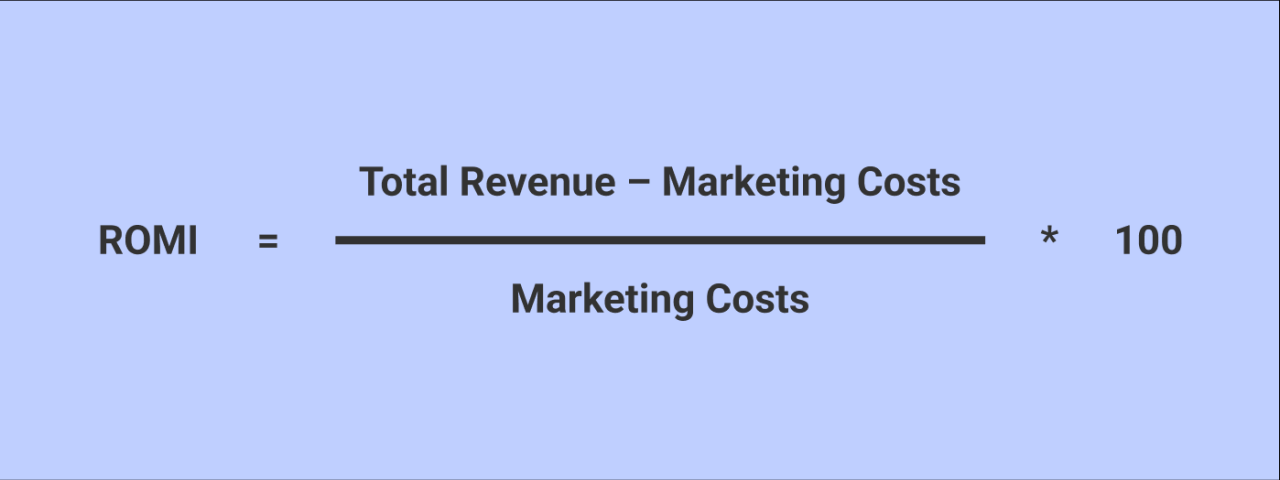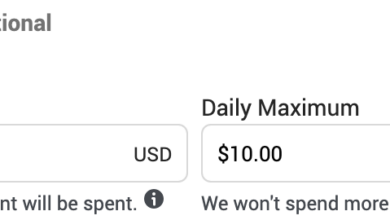
ROMI vs ROAS Marketing Metric A Deep Dive
ROMI vs ROAS marketing metric sets the stage for understanding the nuances of marketing return. This exploration delves into the key differences between Return on Marketing Investment (ROMI) and Return on Ad Spend (ROAS), examining their calculations, applications, limitations, and optimization strategies. We’ll uncover which metric is best suited for various situations and marketing channels, providing a comprehensive guide to maximizing marketing effectiveness.
The comparison extends beyond basic definitions, offering practical insights into how businesses can use these metrics to evaluate the performance of digital marketing campaigns and optimize their strategies for maximum profitability. We’ll also discuss the limitations of each metric and how external factors can influence their interpretation, ensuring a thorough understanding of their practical application.
Defining ROMI and ROAS: Romi Vs Roas Marketing Metric

Understanding Return on Marketing Investment (ROMI) and Return on Ad Spend (ROAS) is crucial for any marketer. These metrics provide insights into the effectiveness of marketing campaigns and advertising efforts, helping businesses optimize their strategies for better returns. By comparing these metrics, businesses can identify areas for improvement and allocate resources more effectively.Marketing success isn’t just about generating leads; it’s about generating profitable leads.
While ROMI and ROAS are both crucial marketing metrics, understanding their differences is key. ROAS focuses solely on the revenue generated compared to ad spend, whereas ROMI considers the overall return on investment, factoring in all costs. A great example of optimizing for increased user acquisition, and the impact on these metrics, can be seen in this SEO and CRO case study focusing on boosting new users seo cro case study increase new users.
Ultimately, the best approach often hinges on aligning your goals with your specific business needs, which directly influences the importance of these metrics for evaluating success.
Knowing how much profit a marketing campaign generates relative to its cost is key to measuring its true effectiveness. Both ROMI and ROAS play critical roles in this evaluation.
Understanding ROMI versus ROAS is crucial for any ecommerce business. ROAS focuses on the revenue generated for every dollar spent on advertising, while ROMI considers the overall return on investment, factoring in all costs. To boost your ROI, check out these 7 ecommerce strategies to increase ROI by 90% 7 ecommerce strategies increase roi 90. Ultimately, a solid grasp of both metrics is key for making smart decisions about marketing spend and achieving profitable growth.
Return on Marketing Investment (ROMI) Definition
ROMI measures the profitability of a marketing campaign relative to its cost. It’s a comprehensive metric that considers all marketing-related expenses, not just advertising costs. A high ROMI indicates a successful campaign, whereas a low ROMI suggests a need for adjustments to the marketing strategy.
Return on Ad Spend (ROAS) Definition
ROAS focuses specifically on the profitability of advertising campaigns. It measures the revenue generated for every dollar spent on advertising. A high ROAS suggests effective ad campaigns, while a low ROAS signals potential issues with ad targeting, messaging, or campaign structure.
Key Differences Between ROMI and ROAS
ROMI considers the entire marketing investment, including all expenses associated with a campaign, such as staff salaries, event costs, and marketing materials. ROAS, in contrast, is limited to the return generated for every dollar spent on advertising. This difference highlights that ROAS is a more focused metric, while ROMI is a more holistic approach to measuring marketing success.
Calculation Methods for ROMI and ROAS
The calculation of ROMI and ROAS differs based on the scope they cover. ROMI is calculated by dividing the net profit from a marketing campaign by the total marketing investment.
ROMI = (Net Profit from Marketing Campaign / Total Marketing Investment) – 100%
ROAS, on the other hand, is calculated by dividing the revenue generated by the ad spend.
ROAS = (Revenue Generated / Ad Spend)
Common Metrics Used in Calculating ROMI and ROAS
Several key metrics are essential for accurately calculating both ROMI and ROAS. These include:
- Revenue Generated: The total revenue generated directly attributable to the marketing campaign or ad campaign.
- Marketing Investment: All costs associated with the marketing campaign, including salaries, materials, and events.
- Ad Spend: The specific cost of the advertising campaign.
- Net Profit: The total revenue generated minus all related costs.
Comparison Table: ROMI vs. ROAS
The table below summarizes the key differences between ROMI and ROAS.
| Metric | Definition | Calculation | Key Differences |
|---|---|---|---|
| ROMI | Return on Marketing Investment; measures profitability of a marketing campaign. | (Net Profit from Marketing Campaign / Total Marketing Investment) – 100% | Considers all marketing expenses, not just ad spend. Provides a broader picture of campaign profitability. |
| ROAS | Return on Ad Spend; measures the revenue generated for every dollar spent on advertising. | (Revenue Generated / Ad Spend) | Focuses specifically on the profitability of advertising. A more focused metric for evaluating ad campaign performance. |
Applications and Use Cases
Choosing between Return on Marketing Investment (ROMI) and Return on Ad Spend (ROAS) hinges on the specific marketing goals and the nature of the investment. Both metrics are crucial for evaluating marketing effectiveness, but their strengths lie in different applications. Understanding when to prioritize one over the other is key to making informed decisions and maximizing campaign ROI.ROMI provides a broader view of marketing’s overall contribution to the bottom line, while ROAS focuses on the direct revenue generated from specific advertising campaigns.
Context is critical. A large-scale brand awareness campaign might be better evaluated with ROMI, whereas a highly targeted paid advertising campaign would likely benefit from ROAS analysis.
When ROMI is the Preferred Metric
ROMI is the superior metric when evaluating the impact of marketing initiatives on the entire business, rather than on a specific ad campaign. This encompasses long-term brand building efforts, public relations campaigns, content marketing strategies, and initiatives aiming to enhance customer lifetime value. Consider a company launching a new product line with a comprehensive marketing campaign that includes social media engagement, influencer collaborations, and print advertisements.
Tracking the overall increase in brand recognition, market share, and customer acquisition cost against revenue generated provides a more holistic view of marketing’s impact.
When ROAS is the Preferred Metric
ROAS is the preferred metric for evaluating short-term, direct-response campaigns. These campaigns often aim for immediate sales or lead generation. Paid advertising, especially pay-per-click (PPC) campaigns, are prime examples. Tracking the revenue generated from a specific Google Ads campaign, for instance, and comparing it to the cost of those ads is a direct and immediate measure of the campaign’s effectiveness.
ROMI and ROAS in Different Marketing Channels
Different marketing channels lend themselves better to one metric or the other. For instance, content marketing, often focused on building brand awareness and long-term engagement, is more suitably measured by ROMI. Social media marketing, aiming for both brand building and lead generation, might benefit from a combination of ROMI and ROAS, analyzing brand lift and direct conversions respectively.
Conversely, paid search advertising and display advertising campaigns are ideally assessed using ROAS, focusing on the direct revenue generated by the ad spend.
Measuring Digital Marketing Campaign Effectiveness
Digital marketing campaigns, particularly those using tools like Google Analytics and CRM platforms, can benefit from both ROMI and ROAS analysis. By tracking website traffic, conversions, and customer journey data, marketers can gain a comprehensive view of the campaign’s impact. Analyzing ROAS from specific campaigns, alongside overall ROMI from the broader marketing strategy, provides a nuanced understanding of the campaign’s efficacy.
Evaluating Marketing Strategies with ROMI and ROAS
Different marketing strategies require different metrics. A company focusing on building a strong brand identity, for example, may prioritize ROMI to measure the long-term impact on brand equity. A company pursuing rapid growth, focused on maximizing short-term sales, would likely prioritize ROAS to gauge the immediate effectiveness of their campaigns.
Comparison Table of Marketing Channels and Preferred Metrics
| Marketing Channel | Preferred Metric | Rationale |
|---|---|---|
| Content Marketing | ROMI | Focuses on long-term brand building and customer engagement. |
| Social Media Marketing | ROMI/ROAS | Combines brand awareness and lead generation, thus requiring both metrics. |
| Paid Search Advertising | ROAS | Directly correlates ad spend with generated revenue. |
| Email Marketing | ROMI/ROAS | Impacts both long-term customer relationships and short-term sales. |
| Public Relations | ROMI | Focuses on overall brand image and reputation. |
Limitations and Considerations
ROMI and ROAS, while powerful marketing metrics, aren’t without their limitations. Understanding these constraints is crucial for accurate interpretation and effective business decision-making. A superficial analysis of these metrics can lead to flawed conclusions and suboptimal strategies. It’s essential to consider the nuances of time, external factors, and the overall business context when evaluating these metrics.Interpreting these metrics in isolation can be misleading.
A high ROAS might seem promising, but if the time horizon is too short, it could mask longer-term negative impacts on profitability. Conversely, a low ROAS might be a temporary blip due to external factors or a strategic shift. A deep dive into the context surrounding the data is necessary to understand its true significance.
Potential Limitations of Using ROMI
The calculation of Return on Marketing Investment (ROMI) relies heavily on accurate estimations of marketing costs and the precise attribution of revenue to specific marketing campaigns. In complex marketing strategies, this attribution can be challenging, potentially leading to inaccurate ROMI calculations. Moreover, ROMI often assumes a linear relationship between marketing investment and revenue generation, which might not always hold true in dynamic market environments.
Potential Limitations of Using ROAS
Return on Ad Spend (ROAS) focuses solely on the revenue generated from advertising expenditure. It doesn’t account for other critical factors, like customer acquisition cost (CAC) or the overall marketing budget. A high ROAS might not be sustainable if the CAC is also high. This can result in a poor return on investment for the business overall.
Time Horizon’s Impact on ROMI and ROAS
The time horizon significantly affects the interpretation of both ROMI and ROAS. A short-term focus might show high ROAS but mask the long-term profitability of a campaign. For example, a flash sale might generate a high ROAS in the immediate period but might not be sustainable over the long term. A longer time horizon provides a more comprehensive view of the true profitability of the marketing strategy.
Challenges in Measuring ROMI and ROAS
Accurately measuring ROMI and ROAS can be challenging. The complexity of marketing strategies, the numerous touchpoints in the customer journey, and the presence of external factors can all affect the attribution of revenue to specific marketing efforts. Consequently, using historical data and benchmarks to evaluate ROMI and ROAS can be misleading in dynamic market situations.
Importance of Overall Business Objectives
When using ROMI and ROAS, it’s crucial to consider the broader business objectives. A high ROAS might be beneficial for short-term revenue growth, but it might not align with long-term brand building or customer retention goals. These metrics should be viewed in the context of the overall business strategy.
Potential Pitfalls in Using ROMI and ROAS
One pitfall is using these metrics in isolation. They should be combined with other marketing performance indicators to provide a more holistic view of marketing effectiveness. Another pitfall is focusing solely on short-term gains, potentially neglecting the long-term value of a marketing campaign.
Impact of External Factors
External factors, such as economic downturns, shifts in consumer behavior, or industry-specific trends, can significantly impact ROMI and ROAS. For example, during a recession, consumer spending might decrease, directly affecting the revenue generated from marketing efforts, and thus lowering the ROAS. This emphasizes the need to consider external factors when evaluating these metrics.
Table: Limitations of ROMI and ROAS and Potential Solutions
| Limitation | Potential Solution |
|---|---|
| Inaccurate attribution of revenue to specific marketing campaigns | Employ advanced attribution modeling techniques, utilize multi-touch attribution, and consider various touchpoints in the customer journey. |
| Overemphasis on short-term gains | Establish long-term marketing strategies and track ROI over an extended period, focusing on brand building and customer retention. |
| Lack of consideration for overall business objectives | Integrate ROMI and ROAS with other marketing metrics and business goals to evaluate their impact on the overall profitability and strategic alignment of the business. |
| Impact of external factors (e.g., economic conditions) | Regularly monitor external economic conditions and adjust marketing strategies accordingly. Incorporate scenario planning into the analysis. |
Optimizing Marketing Strategies

Turning ROMI and ROAS data into actionable insights is crucial for any marketing campaign’s success. Understanding how these metrics perform allows for strategic adjustments that can significantly boost return on investment. This section delves into practical techniques for optimizing your marketing strategies based on these vital figures.
Leveraging ROMI and ROAS Data for Campaign Optimization
Analyzing ROMI and ROAS data is not just about understanding past performance; it’s about actively shaping future outcomes. By meticulously examining the data, marketers can identify areas for improvement, refine strategies, and allocate resources more effectively. This iterative approach is fundamental to optimizing marketing efforts.
Adjusting Marketing Spend Based on Performance
A critical aspect of optimization is adapting your marketing budget based on the performance of different campaigns. If a specific channel or campaign is consistently underperforming, reducing its allocation frees up resources to be channeled into more successful areas. Conversely, channels demonstrating high ROMI and ROAS should be prioritized and receive increased budgets. This dynamic allocation is key to achieving maximum return on investment.
Strategies for Improving ROMI and ROAS Over Time
Continuous improvement is essential for maintaining a high return on marketing investments. Strategies like A/B testing, focusing on high-converting customer segments, and refining messaging based on customer feedback can all significantly improve ROMI and ROAS. Regular review and analysis of performance data are vital to identify emerging trends and opportunities.
Identifying and Targeting High-Performing Marketing Channels
High-performing marketing channels are crucial for driving substantial returns. These channels often exhibit strong engagement, conversion rates, and overall profitability. Identifying these channels requires a deep dive into campaign data, including click-through rates, conversion rates, and customer lifetime value (CLTV). Understanding these crucial aspects allows marketers to concentrate resources and efforts in areas yielding the most effective outcomes.
A/B Testing Strategies Using ROMI and ROAS
A/B testing is a powerful tool for optimizing marketing strategies. It allows for the comparison of two different versions of a campaign element, such as ad copy or landing page design, to determine which performs better in terms of ROMI and ROAS. For example, testing different call-to-actions (CTAs) on a landing page can lead to a significant improvement in conversions and, consequently, a higher ROAS.
Figuring out ROMI versus ROAS can be tricky, right? It’s all about return on investment (ROMI) versus return on ad spend (ROAS). A key factor in understanding these metrics, and how to best utilize them, is understanding the context from industry leaders. For example, Chris Capossela, CMO of Microsoft, Chris Capossela cmo microsoft frequently discusses the nuances of these metrics in the digital marketing sphere.
Ultimately, the best approach to determining which metric is best depends heavily on your specific business goals.
By systematically testing various elements, marketers can refine their campaigns and maximize their impact.
Step-by-Step Guide to Optimize Marketing Strategies
1. Analyze existing data
Carefully review historical ROMI and ROAS data across all marketing channels.
2. Identify underperforming channels
Determine which channels are consistently underperforming in terms of both ROMI and ROAS.
3. Adjust budgets
Reduce spending on underperforming channels and reallocate funds to high-performing channels.
4. Implement A/B testing
Conduct A/B tests on different aspects of campaigns to identify improvements in conversion rates and, ultimately, ROMI and ROAS.
5. Refine targeting
Refine targeting strategies to focus on high-value customer segments.
6. Monitor and adapt
Continuously monitor performance and adapt strategies based on the latest data.
Correlation Between Marketing Strategies, ROMI, and ROAS
| Marketing Strategy | ROMI | ROAS |
|---|---|---|
| Content Marketing | High | Moderate to High |
| Social Media Marketing | Moderate | Moderate |
| Search Engine Marketing (SEM) | High | High |
| Email Marketing | Moderate | Moderate to High |
| Paid Advertising (PPC) | High | High |
Note: The correlation between ROMI and ROAS can vary depending on factors like industry, campaign specifics, and target audience.
Illustrative Examples
Understanding the nuances of Return on Marketing Investment (ROMI) and Return on Ad Spend (ROAS) is crucial for effective marketing strategy. These metrics provide quantifiable insights into the profitability of marketing campaigns, allowing businesses to optimize their spending and maximize their return. This section delves into practical examples showcasing how ROMI and ROAS are used in various scenarios and industries.
ROMI Example: E-commerce Website Launch
A new e-commerce website launched a multi-channel marketing campaign, including social media advertising, email marketing, and search engine optimization (). The campaign’s goal was to increase brand awareness and drive sales. To calculate ROMI, the campaign’s total costs were subtracted from the total revenue generated within a specific timeframe.
ROMI = (Total Revenue – Total Marketing Costs) / Total Marketing Costs
For instance, if the campaign generated $50,000 in revenue and cost $10,000, the ROMI would be 400%. This indicates that for every dollar invested in marketing, the business generated $4 in profit. The campaign’s success, measured by ROMI, demonstrated the effectiveness of the chosen marketing strategies in boosting sales.
ROAS Example: Online Advertising Campaign
A software company ran an online advertising campaign on Google Ads to promote a new product. The campaign’s primary objective was to generate leads and drive sales. The campaign’s cost-effectiveness was evaluated using ROAS. If the campaign generated $20,000 in revenue and had $5,000 in ad spend, the ROAS would be 4.0. This means that for every dollar spent on advertising, the company generated $4 in revenue.
Industries and Metrics Usage, Romi vs roas marketing metric
Different industries utilize ROMI and ROAS in various ways. Retailers frequently track ROAS for online advertising campaigns, aiming to maximize the return on their advertising budget. Software companies might employ ROMI to assess the overall effectiveness of their marketing strategies in generating leads and driving sales across different channels. Service businesses can use both metrics to gauge the profitability of marketing initiatives.
Case Study: Digital Marketing Campaign for a SaaS Company
A software-as-a-service (SaaS) company, “Cloud Solutions,” launched a comprehensive digital marketing campaign targeting small businesses. The campaign included content marketing, social media marketing, and paid advertising. The campaign’s goals were to increase website traffic, generate leads, and ultimately convert them into paying customers.The marketing team tracked website traffic, lead generation, and sales data meticulously. They meticulously calculated ROAS for each marketing channel.
For instance, paid advertising campaigns had a ROAS of 3.5, indicating a significant return for each dollar spent. The campaign’s ROMI was calculated by comparing the total revenue generated from the campaign to the total cost. The overall ROMI was 250%, demonstrating a highly effective and profitable campaign.
Interpreting ROMI and ROAS Data
Data from various sources, including CRM systems, marketing automation platforms, and advertising dashboards, can be used to calculate ROMI and ROAS. It is crucial to ensure data consistency and accuracy to derive meaningful insights. For instance, tracking the number of leads generated through social media campaigns, the conversion rate from leads to customers, and the average revenue generated per customer is critical.
ROMI and ROAS Calculations in Various Industries
| Industry | ROMI Example | ROAS Example |
|---|---|---|
| E-commerce | 150% (for a website launch campaign) | 3.0 (for a social media advertising campaign) |
| Software | 200% (for a content marketing campaign) | 2.5 (for a Google Ads campaign) |
| Financial Services | 100% (for a digital marketing campaign) | 5.0 (for a targeted advertising campaign) |
Summary
In conclusion, understanding the differences between ROMI and ROAS is crucial for any marketing professional aiming to optimize campaign performance. This detailed comparison provides a clear framework for choosing the appropriate metric for specific scenarios and strategies. By considering the limitations, and leveraging the insights gained, businesses can make data-driven decisions, ultimately improving marketing ROI and achieving their overall business objectives.
The key takeaway? Choose the right metric for the right situation and use it effectively to drive results.





